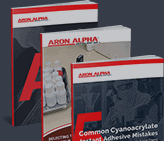The Strength Behind Industrial Super Glue
The strength behind industrial super glue is often a topic of conversation with our customers. So we thought we would create this post to provide an overview in an attempt to cover this topic. As we mentioned in a prior post, keep in mind, not all super glues are created equal. In fact, there are varying types of super glues (also known as cyanoacrylates), that are intended for various type of applications.
Super glue is a versatile adhesive technology because of its chemistry, it can work with any surface that contains moisture. Cyanoacrylate monomers are very reactive to water thus clamp together to form polymers and adhere objects together.
Krazy Glue consists of this material (cyanoacrylate), which is an acrylic resin intended to bond strongly to almost anything instantaneously. This chemical reaction called anionic polymerization involves the acrylic resin reacting to the hydroxyl ions from water, and because small traces of water can be found on almost every surface known to man, Krazy Glue bonds strongly to most substrates. The water on the surface and in the atmosphere triggers the cyanoacrylate molecules to link and form a very long polymeric chain. They link together to form a super-strong plastic mesh, and this only stops after the glue has become polymerized into a solid bond line. After that point, the molecular chains can no longer move. The surfaces that are to be mated ought to properly fit together in order to achieve excellent bonding. Super glue can be purchased in various viscosities from water thin wicking grades to no-run, no-sag gels that allow for some leeway in the gap filling performance. Super glue is recommended for rubber (elastomers), plastics, metal, wood, ceramic and leather bonding or repair applications.
To be a bit more technical, this glue has two main forces called mechanical bonding and the Van der Waals forces. When talking about mechanical bonding, the liquid glue seeps into the crevices and cracks of the object’s surface. That is one of the reasons cyanoacrylate bonds so well with the skin. A human’s skin has many tiny crevices, and it is full of water. As a result, the glue seeps in deep and hardens. Next, there is the van der Waals force, which refers to the attraction found between the molecules of the glue. Cyanoacrylate hardens and cures almost instantly, and even trace levels of humidity in the air can cause a hardening of the glue. A dirty surface should first be cleaned because the glue will bond to the dirt and have a weakened effect. There is no doubt it that the strength behind these bonding forces make cyanoacrylates the ideal choice when quick cure and high strength are a must.
We hope this post has been helpful in providing an overview as to the strength behind super glues or cyanoacrylates for your next application. For more information on selecting the right cyanoacrylate industrial adhesive and how you can improve your productivity in your assembly process, contact us at 1-800-338-5192 or email us at sales@aronalpha.net. You can also visit us on the web at www.aronalpha.net.




